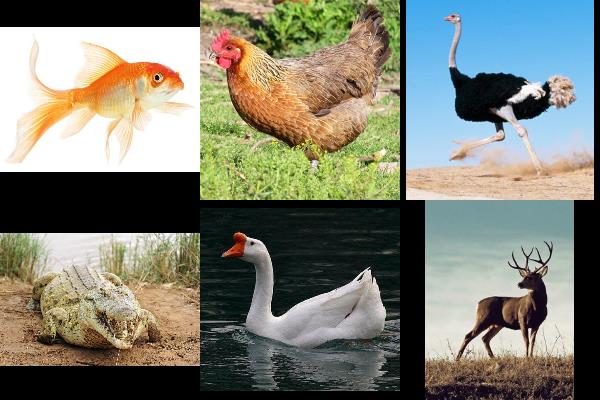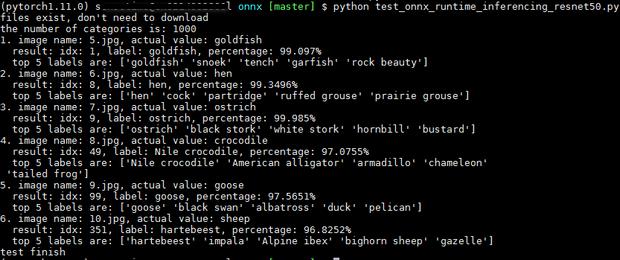ONNX Runtime介绍
Posted fengbingchun
tags:
篇首语:本文由小常识网(cha138.com)小编为大家整理,主要介绍了ONNX Runtime介绍相关的知识,希望对你有一定的参考价值。
ONNX Runtime:由微软推出,用于优化和加速机器学习推理和训练,适用于ONNX模型,是一个跨平台推理和训练机器学习加速器(ONNX Runtime is a cross-platform inference and training machine-learning accelerator),源码地址:https://github.com/microsoft/onnxruntime,最新发布版本为v1.11.1,License为MIT:
1.ONNX Runtime Inferencing:高性能推理引擎
(1).可在不同的操作系统上运行,包括Windows、Linux、Mac、android、ios等;
(2).可利用硬件增加性能,包括CUDA、TensorRT、DirectML、OpenVINO等;
(3).支持PyTorch、TensorFlow等深度学习框架的模型,需先调用相应接口转换为ONNX模型;
(4).在Python中训练,确可部署到C++/Java等应用程序中。
2.ONNX Runtime Training:于2021年4月发布,可加快PyTorch对模型训练,可通过CUDA加速,目前多用于Linux平台。
通过conda命令安装执行:
conda install -c conda-forge onnxruntime以下为测试代码:通过ResNet-50对图像进行分类
import numpy as np
import onnxruntime
import onnx
from onnx import numpy_helper
import urllib.request
import os
import tarfile
import json
import cv2
# reference: https://github.com/onnx/onnx-docker/blob/master/onnx-ecosystem/inference_demos/resnet50_modelzoo_onnxruntime_inference.ipynb
def download_onnx_model():
labels_file_name = "imagenet-simple-labels.json"
model_tar_name = "resnet50v2.tar.gz"
model_directory_name = "resnet50v2"
if os.path.exists(model_tar_name) and os.path.exists(labels_file_name):
print("files exist, don't need to download")
else:
print("files don't exist, need to download ...")
onnx_model_url = "https://s3.amazonaws.com/onnx-model-zoo/resnet/resnet50v2/resnet50v2.tar.gz"
imagenet_labels_url = "https://raw.githubusercontent.com/anishathalye/imagenet-simple-labels/master/imagenet-simple-labels.json"
# retrieve our model from the ONNX model zoo
urllib.request.urlretrieve(onnx_model_url, filename=model_tar_name)
urllib.request.urlretrieve(imagenet_labels_url, filename=labels_file_name)
print("download completed, start decompress ...")
file = tarfile.open(model_tar_name)
file.extractall("./")
file.close()
return model_directory_name, labels_file_name
def load_labels(path):
with open(path) as f:
data = json.load(f)
return np.asarray(data)
def images_preprocess(images_path, images_name):
input_data = []
for name in images_name:
img = cv2.imread(images_path + name)
img = cv2.resize(img, (224, 224))
img = cv2.cvtColor(img, cv2.COLOR_BGR2RGB)
data = np.array(img).transpose(2, 0, 1)
#print(f"name: name, opencv image shape(h,w,c): img.shape, transpose shape(c,h,w): data.shape")
# convert the input data into the float32 input
data = data.astype('float32')
# normalize
mean_vec = np.array([0.485, 0.456, 0.406])
stddev_vec = np.array([0.229, 0.224, 0.225])
norm_data = np.zeros(data.shape).astype('float32')
for i in range(data.shape[0]):
norm_data[i,:,:] = (data[i,:,:]/255 - mean_vec[i]) / stddev_vec[i]
# add batch channel
norm_data = norm_data.reshape(1, 3, 224, 224).astype('float32')
input_data.append(norm_data)
return input_data
def softmax(x):
x = x.reshape(-1)
e_x = np.exp(x - np.max(x))
return e_x / e_x.sum(axis=0)
def postprocess(result):
return softmax(np.array(result)).tolist()
def inference(onnx_model, labels, input_data, images_name, images_label):
session = onnxruntime.InferenceSession(onnx_model, None)
# get the name of the first input of the model
input_name = session.get_inputs()[0].name
count = 0
for data in input_data:
print(f"count+1. image name: images_name[count], actual value: images_label[count]")
count += 1
raw_result = session.run([], input_name: data)
res = postprocess(raw_result)
idx = np.argmax(res)
print(f" result: idx: idx, label: labels[idx], percentage: round(res[idx]*100, 4)%")
sort_idx = np.flip(np.squeeze(np.argsort(res)))
print(" top 5 labels are:", labels[sort_idx[:5]])
def main():
model_directory_name, labels_file_name = download_onnx_model()
labels = load_labels(labels_file_name)
print("the number of categories is:", len(labels)) # 1000
images_path = "../../data/image/"
images_name = ["5.jpg", "6.jpg", "7.jpg", "8.jpg", "9.jpg", "10.jpg"]
images_label = ["goldfish", "hen", "ostrich", "crocodile", "goose", "sheep"]
if len(images_name) != len(images_label):
print("Error: images count and labes'length don't match")
return
input_data = images_preprocess(images_path, images_name)
onnx_model = model_directory_name + "/resnet50v2.onnx"
inference(onnx_model, labels, input_data, images_name, images_label)
print("test finish")
if __name__ == "__main__":
main()测试图像如下所示:

执行结果如下所示:

GitHub: https://github.com/fengbingchun/PyTorch_Test
以上是关于ONNX Runtime介绍的主要内容,如果未能解决你的问题,请参考以下文章
Pytorch的pth模型转onnx,再用ONNX Runtime调用推理(附python代码)
微软推出了Cloud Native Application Bundles和开源ONNX Runtime
Pytorch基础教程33spark或dl模型部署(MLFlow/ONNX/Runtime/tensorflow serving)